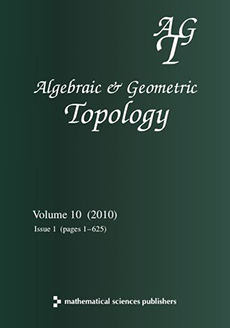Abstract
We show that the map on components from the space of classical long knots to the stage of its Goodwillie–Weiss embedding calculus tower is a map of monoids whose target is an abelian group and which is invariant under clasper surgery. We deduce that this map on components is a finite type- knot invariant. We compute the –page in total degree zero for the spectral sequence converging to the components of this tower: it consists of –modules of primitive chord diagrams, providing evidence for the conjecture that the tower is a universal finite-type invariant over the integers. Key to these results is the development of a group structure on the tower compatible with connected sum of knots, which in contrast with the corresponding results for the (weaker) homology tower requires novel techniques involving operad actions, evaluation maps and cosimplicial and subcubical diagrams.
Citation
Ryan Budney. James Conant. Robin Koytcheff. Dev Sinha. "Embedding calculus knot invariants are of finite type." Algebr. Geom. Topol. 17 (3) 1701 - 1742, 2017. https://doi.org/10.2140/agt.2017.17.1701
Information





